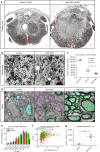Locomotor recovery following contusive spinal cord injury does not require oligodendrocyte remyelination
- PMID: 30076300
- PMCID: PMC6076268
- DOI: 10.1038/s41467-018-05473-1
Locomotor recovery following contusive spinal cord injury does not require oligodendrocyte remyelination
Abstract
Remyelination occurs after spinal cord injury (SCI) but its functional relevance is unclear. We assessed the necessity of myelin regulatory factor (Myrf) in remyelination after contusive SCI by deleting the gene from platelet-derived growth factor receptor alpha positive (PDGFRα-positive) oligodendrocyte progenitor cells (OPCs) in mice prior to SCI. While OPC proliferation and density are not altered by Myrf inducible knockout after SCI, the accumulation of new oligodendrocytes is largely prevented. This greatly inhibits myelin regeneration, resulting in a 44% reduction in myelinated axons at the lesion epicenter. However, spontaneous locomotor recovery after SCI is not altered by remyelination failure. In controls with functional MYRF, locomotor recovery precedes the onset of most oligodendrocyte myelin regeneration. Collectively, these data demonstrate that MYRF expression in PDGFRα-positive cell derived oligodendrocytes is indispensable for myelin regeneration following contusive SCI but that oligodendrocyte remyelination is not required for spontaneous recovery of stepping.
Conflict of interest statement
The authors declare no competing interests.
Figures







References
-
- Fawcett JW, et al. Guidelines for the conduct of clinical trials for spinal cord injury as developed by the ICCP panel: spontaneous recovery after spinal cord injury and statistical power needed for therapeutic clinical trials. Spinal Cord. 2007;45:190–205. doi: 10.1038/sj.sc.3102007. - DOI - PubMed
-
- Hilton BJ, et al. Re-establishment of cortical motor output maps and spontaneous functional recovery via spared dorsolaterally projecting corticospinal neurons after dorsal column spinal cord injury in adult mice. J. Neurosci. 2016;36:4080–4092. doi: 10.1523/JNEUROSCI.3386-15.2016. - DOI - PMC - PubMed
Publication types
MeSH terms
Substances
Grants and funding
LinkOut - more resources
Full Text Sources
Other Literature Sources
Medical
Molecular Biology Databases
Miscellaneous

